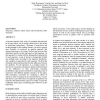Free Online Productivity Tools
i2Speak
i2Symbol
i2OCR
iTex2Img
iWeb2Print
iWeb2Shot
i2Type
iPdf2Split
iPdf2Merge
i2Bopomofo
i2Arabic
i2Style
i2Image
i2PDF
iLatex2Rtf
Sci2ools
GAMEON
2009
2009
Analysis of User Trajectories Based on Data Distribution and State Transition: a Case Study with a Massively Multiplayer Online
At present, trajectory data, series of coordinate data traversed by moving objects, can be readily obtained due to the advent of positioning technologies. Clustering of trajectories and giving meanings to the resulting clusters is an active research area. Recently, we proposed an analysis approach that clusters trajectories in two steps: the first step based on data distribution and the second step based on state transition. In this approach, for coping with the distinguished characteristic of each trajectory, a map of interest is dynamically divided into multiple states, according to the trajectory distribution, and a quadtree is generated for each trajectory. The first-step clustering is then performed based on the differences between the quadtrees. For all trajectories in a resulting cluster of interest, the second-step clustering is further performed based on the differences in their state-to-state transition probabilities using a proposed method for comparing a pair of trajectori...
| Added | 17 Feb 2011 |
| Updated | 17 Feb 2011 |
| Type | Journal |
| Year | 2009 |
| Where | GAMEON |
| Authors | Ruck Thawonmas, Junichi Oda, Kuan-Ta Chen |
Comments (0)

